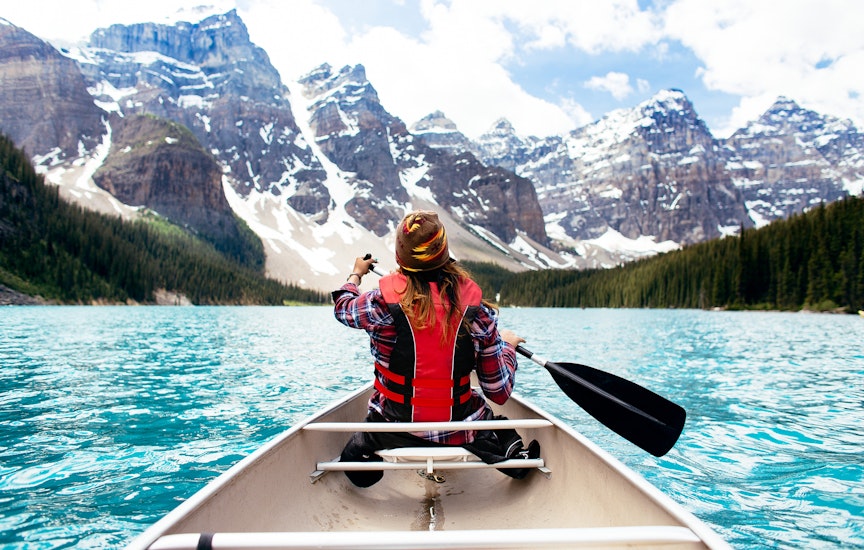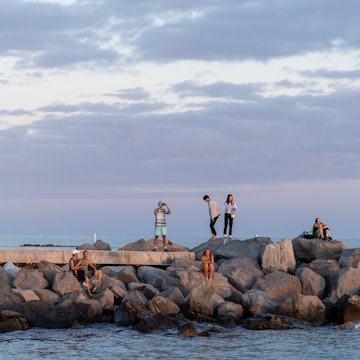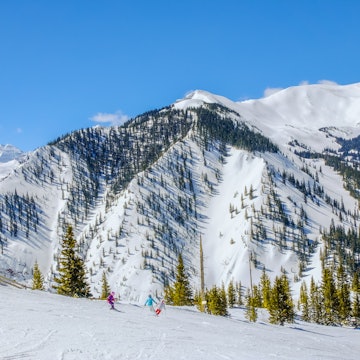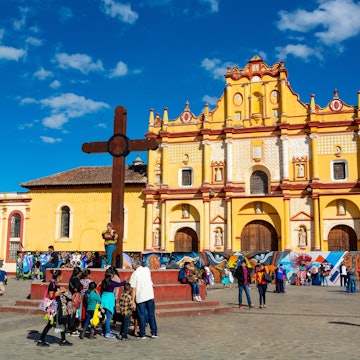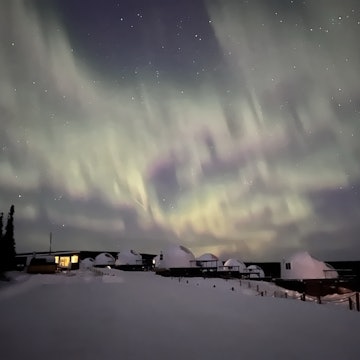

The northern lights above the mountains of Tromsø. Shutterstock
If seeing the aurora borealis (northern lights) is on your bucket list, turn your attention skyward: experts say 2025 is set to be a great year for spotting the elusive light show.
The natural phenomenon is usually observable around the Arctic Circle, but the lights were particularly active in late 2024 and this has continued into 2025, giving people across large swaths of the US and Europe a chance to see the ethereal display. Here's everything you need to know to catch a solar performance this year.
What is the aurora borealis (northern lights)?
"Auroras happen because charged particles from the sun interact with the Earth's magnetic field," says Dr. Shannon Schmoll, director of the Abrams Planetarium at Michigan State University. "This process excites gas atoms in our atmosphere that release light as they calm back down." Different gasses result in various colors, setting the celestial stage for psychedelic ballets that might appear green, purple, blue, red or yellow.
This phenomenon occurs in an area called the "auroral oval" or "auroral zone." In the Northern Hemisphere, the region usually encompasses high latitudes like Alaska, Northern Canada, Russia and the Nordics. But the zone shifts depending on the strength of solar storms, which release huge amounts of charged particles. Scientists predict the sun is on track for a stormy season.

What's unique about the northern lights in 2025?
In October 2024, NASA scientists announced that the sun has officially reached its "solar maximum" – the peak of an 11-year cycle when solar activity is greatest – and could continue until October 2025.
The level of solar activity is currently the highest it's been in about 20 years, when prolonged geomagnetic storms known as the Great Halloween Storms of 2003, made the northern lights visible as far south as Florida, Texas and the Mediterranean.
The biggest storm on record is still the Carrington Event in 1859. "It was strong enough for northern lights to be seen as far south as Mexico," says Schmoll.
If the sun replicates this solar flare, Earth is in for a treat. But solar activity is erratic. There's no light switch for the aurora borealis, and hopefuls in lower latitudes shouldn't spend sleepless nights staring skyward.
How to see the northern lights in 2025
Even if you join a top-dollar aurora expedition, there's no guarantee you'll see a solar show. But according to the National Oceanic and Atmospheric Association (NOAA), there are several things you can do to increase your chances.
Get out of the city
First, avoid bright lights. Shining cities will drown out the aurora, so your best bet is to find an International Dark Sky Park or Sanctuary with exceptionally inky skies. In the US, you could find luck at Montana's Glacier National Park, Michigan's Headlands International Dark Sky Park, or Maine's Katahdin Woods and Waters National Monument. All are far enough north that this year's solar storms might make a surprise appearance.
It's also helpful to travel outside of a full moon. Consult the moon calendar for 2025 and plan a trip when the moon is a crescent.

Choose the right season
It's imperative to consider timing, too. Spotting the aurora is a night owl's quest, with peak viewing usually between 10pm and 2am local time – though this changes seasonally. The best months to spot a celestial performance are near the spring and fall equinoxes (March and September) when solar winds tend to be strongest. In summer, the Arctic's midnight sun will thwart your efforts.
Check the local weather
Spotting northern lights also calls for clear skies and a solar storm – though these circumstances are impossible to control. Consulting weather apps, like NOAA's Space Weather Prediction Center website or the My Aurora Forecast and Alerts app, can help – but don't expect 100% accuracy.
Pick the best locations
The most important factor (aside from plenty of patience) is location. "While seeing them farther south is more likely during solar maximum, heading north is always going to give you a better chance," says Schmoll. You can cross your fingers for an aurora in Ireland and Idaho, but if you really want to see the phenomenon, start planning an Arctic adventure.
Where to see the northern lights in 2025
1. Visit the remote Westfjords in Iceland
Located on the southern edge of the Arctic Circle, Iceland is magnificent for light chasers. Most visitors attempt their sightings in the south, where they might capture the green glow through ice boulders on Diamond Beach. Stay at Hotel Rangá where receptionists call interested guests when the aurora appears.
Head north, and your likelihood increases. Iceland's Westfjords, the country's northernmost peninsula, experiences longer nights and less cloud cover than much of the country. There's also little light pollution, thanks to tiny, secluded towns shadowed by steep fjords. For dark skies, head to Bolafjall – a 635m-high mountain above the peninsula's unofficial capital, Ísafjörður – where jet-black skies offer excellent odds of seeing neon streaks.
Where to stay: If you're heading to Bolafjall, Bolungarvik is the closest town with accommodations. However, there are other small towns for those not inclined to climb a mountain. Try Húsið, a boutique hotel in Ísafjörður or the remote Holt Inn, surrounded by stunning Icelandic landscape.
When to visit: The best viewing time for the Westfjords region is between late September and March.

2. Beat the cold in Fairbanks, Alaska
Fairbanks is considered one of the top destinations for viewing the northern lights due to its location right under the auroral oval. Visitors don’t need to venture into the Alaskan wilderness to enjoy the spectacle as the town has minimal light pollution.
Where to stay: At the Aurora Borealis Lodge, 30 minutes south of Fairbanks, guests can view the skies from cozy cabins, hot chocolate in hand. Then there's Chena Hot Springs Resort, one hour east, where you can soak in geothermal waters after a chilly sky-gazing expedition.
When to visit: Aurora season in Alaska generally runs from late August to late April, when chilly temps require warm clothing. For the best opportunities, come when the nights are darkest between November and February.
3. Feast your eyes on the blue hole over Abisko, Sweden
Located 200km north of the Arctic Circle, two mountains hug Abisko to create a cloud-free microclimate at night. The result? A "blue hole" with exceptional clarity for celestial shows. Take a back seat with Lights Over Lapland for an aurora-chasing tour in a winter-ready 4WD vehicle, or head to the lookout tower at STF Aurora Sky Station, where aurora views happen approximately 70% of the nights in it's open.
Where to stay: Abisko Guesthouse provides self-catering accommodation and a range of activities including snowshoe hiking and snowmobile tours. There are also several highly rated hostels in the Swedish town.
When to visit: Abisko’s northern lights season runs from September to March.

4. Cuddle up in a teepee near Yellowknife, Canada
The Indigenous Dene people, who live in Canada's Northwest Territories, have another name for the northern lights – ya'ke ngas, which means "sky stirring." And if you spend time near their home in Yellowknife – located at the auroral oval's center – there's a strong likelihood you'll see the sky stir, too. According to Northwest Territories Tourism, spend three nights in the area and you have a 98% chance of spotting the light show.
Where to stay: Book a three-night experience at Aurora Village to split your time between viewing the electrified sky and staying warm inside a wood stove-heated teepee.
When to visit: Plan your visit between mid-August and late September or mid-November through to early April.
5. Join a guided expedition in Tromsø, Norway
Norway, which straddles the Arctic Circle, is a northern lights magnet. Head to Svalbard, where the polar night gives visitors extra time to see solar storms blaze above the Arctic tundra or join a Viking Cruise as it sails the coast, free from urban light pollution.
In Tromsø, Norway's largest city north of the Arctic Circle, urban lights might not be an aurora deterrent: between October and March, it's easy to spot the "dancing green lady." For optimal light chasing, consider joining a tour. An expert guide like Espen Minde, a Tromsø local with years of experience, can't promise you'll see northern lights – but he can provide plenty of insight whilst you search the skies.
Where to stay: Located on the quay in the center of Tromsø, the Scandic Ishavshotel offers a central base from which to explore and Clarion Hotel The Edge is also a top rated choice.
When to visit: The best time to visit Tromsø and experience the northern lights is from mid-September to mid-April.

6. Try to spot Santa Claus in Rovaniemi, Finland
Rovaniemi is known as the official home of Santa Claus and is also a great place to view the northern lights. The town is the capital of Finnish Lapland and sits right on the Arctic Circle, making it one of the most accessible locations for aurora spotting.
Enjoy a private Finnish dinner at Happy Fox Farm or take a snowmobile tour to chase down the auroras. For a truly unique adventure provided by Sarfartica, try Aurora Ice Floating, where you wear a waterproof suit while floating in the water, taking in the peaceful atmosphere and the northern lights above.
Where to stay: Visitors can enjoy the northern lights from unique accommodations like glass igloos or cozy log cabins, providing a warm and comfortable experience.
Best time to visit: The northern light season in Lapland runs from the end of August to early Spring.
7. Stay in the lower 48 in Michigan's dark sky park
Headlands International Dark Sky Park at Lake Michigan offers one of the best places to see the northern lights in the continental United States. Recognized for its pristine night skies, the park provides an excellent opportunity for stargazing and aurora viewing without the interference of light pollution.
Where to stay: Choose from hotels in nearby Mackinaw or for larger parties rent the Guesthouse at the Headlands. You can also stay at McGulpin Point in accommodation beside the historic lighthouse.
Best time to visit: For the best chances of seeing the northern lights, head to Michigan between August and April. However, the peak months are October and November.

8. Feel the magic in Orkney, Scotland
Orkney, an archipelago off the northeastern coast of Scotland, is an unexpected but rewarding place for people who want to see the northern lights. It's a land of magical myths, and it's easy to see why when the northern lights, known here as the "Merry Dancers," light up the sky.
Some favorite spots for viewing include the coastline at Birsay and the Broch of Gurness. Inganess Bay and Wideford Hill, both just outside Kirkwall, are also easy to reach. Basically, anywhere with a clear view and little light pollution to the north is worth visiting. Unlike their European counterparts, Scotland’s northern lights can be a little more elusive.
Where to stay: Try one of the quaint Anderson’s Harbour Cottages in Stromness for a warm and cozy place to stay while looking for the Merry Dancers.
Best time to visit: Between October and March is the best time to catch a glimpse of the lights. Accommodation during these off-peak seasons is also on the lower side.
9. Discover clear skies in Kangerlussuaq, Greenland
Situated just above the Arctic Circle, this small town offers prime viewing conditions for the auroras, thanks to its remote location and minimal light pollution. The town's international airport has direct flights from Copenhagen, making it one of the more accessible Arctic destinations.
The area is known for its stable weather and 300 days of clear skies per year, enhancing the chances of a spectacular show. Beyond the northern lights, Kangerlussuaq offers breathtaking landscapes, including the impressive Greenland Ice Cap.
Where to stay: The conditions in Kangerlussuaq mean that when the conditions are right, you should be able to see the northern lights from anywhere in town. Guests rated the family-run Hotel Aurora and Hotel Nordlys as favorites.
Best time to visit: The northern lights can be seen from Kangerlussuaq between late September and early April. The long nights of winter, especially between November and February, offer extended periods of darkness for optimal viewing conditions.






